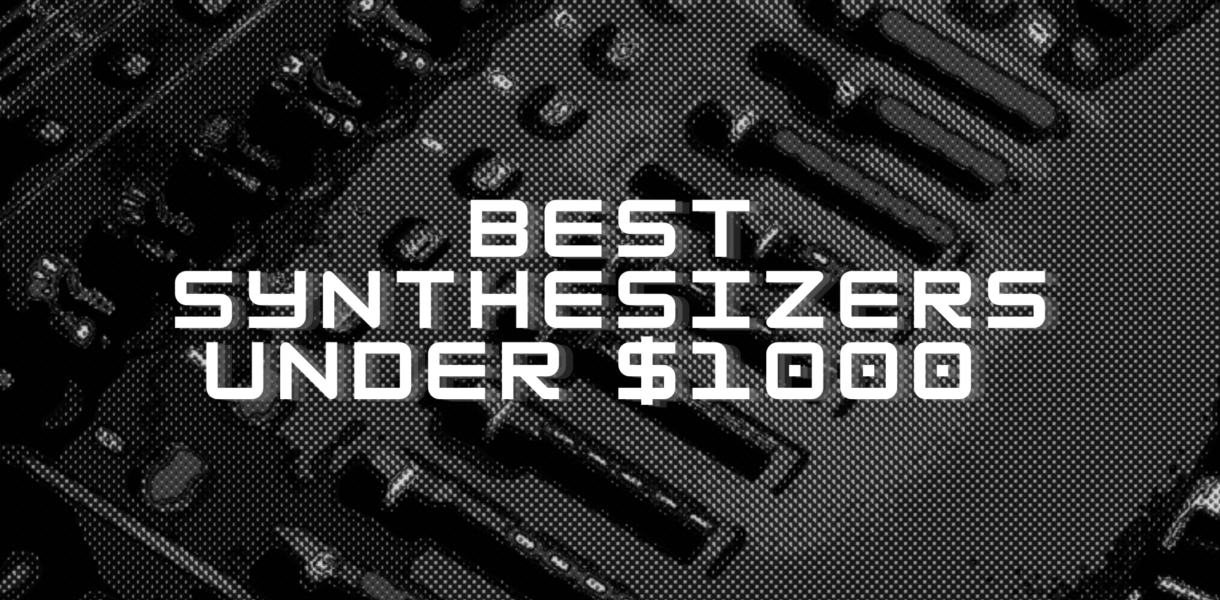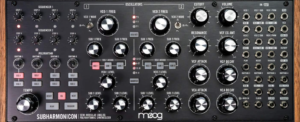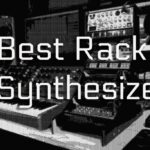Exploring Musical Horizons: The Best Synthesizers Under $1000
Visualize stepping directly into a world of boundless tunes, prospects where you can make mesmerizing pads, innovative leads along with many otherworldly soundscapes. That’s the beauty of synthesizers – these versatile instruments have become an essential tool for those looking to learn even experienced producers and musicians, enabling them to explore any creative ideas.
While high-end synthesizers can cost a fortune, there are many excellent options available for those on a budget. Furthermore, In this blog post, we will explore the best synthesizers under $1000.
| Top Pick | PRODUCT | DETAILS | |
|---|---|---|---|
 |
Roland JUNO-DS
|
|
|
|
TOP OPTIONS
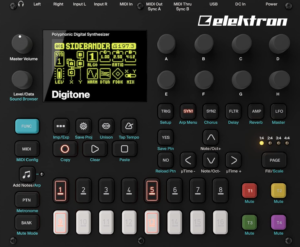 |
Elektron Digitone 8-Voice Polyphonic Digital Synth
|
|
|
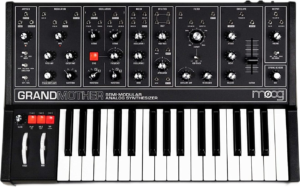 |
Moog Grandmother Dark
|
|
|
|
OUR BUDGET PICK
|
Moog Subharmonicon
|
|
Before You Come To A Decision On Choosing Your Best Synthesizer Under $1000, Ask Yourself What Exactly Am I Looking For?
First, you need to know what you will be using the Synthesizer for. Are you going to be jamming out on the mainstage with it, or are you going to be mainly using it for your studio recordings? Having a clear insight into your purpose will narrow down the search and make things very easy.
Just how many notes do you want the synth to play simultaneously? That’s called polyphony. If you’re into layering sounds or complex chords, we recommend a machine with higher polyphony. Additionally, look into a multitimbral synth that enables you to play various sounds at the same time. Much needed during live shows that may need a bit of sequencing.
Now, here’s a choice to create – are you wanting a synth that provides a built-in keyboard or perhaps a module that may need an external controller? Built-in keyboards are excellent for independent use, but modules are flexible and more compact. Depends on how you like to play along with the current space you have available.
Let’s get practical for a second. Look into obtaining more intel on the sound engine as well as oscillators. These oscillators produce simple waveforms that shape your nose. The more modulation alternatives you have the better, it expands your options on sonics which can never be a problem.
You also can’t forget your connectivity options. USB, MIDI, inputs, audio outputs, and many synths even allow you to expand your setup by a variety of connections, which can help if and when you plan to expand your audio collection. To conclude the checklist we also recommend knowing about the processing & effects. Various devices feature built-in effects like delay, reverb, etc. It’s like having a mini mixing board attached to your synth.
Our last final tip, before you make your choice would be to perform some research and read end-user testimonials. Seeing and hearing many other music artists and different industry professionals who’ve applied the synths can give you some actual informative information about their performance and stability. Bear in mind, an ideal synthesizer to suit your needs is the one that can coexist with your musical style and receives your innovative thoughts plus what you would like to hear. So invest some time, investigate different types, and choose one that speaks to your heart and soul.
Top Best Synthesizers Under $1000
Roland Juno-DS
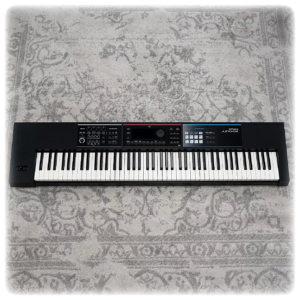 Perfect for any synth lover looking for something a little more portable than the famous Juno-DS88 boasting over 1,000 high-quality patches, the JUNO-DS is a national treasure that carries a wide range of expressive tones that cater to any musical opportunity. From drums, brass, strings, pianos, and beyond, this synthesizer is a sonic palette that will spark creativity and fuel ideas.
Perfect for any synth lover looking for something a little more portable than the famous Juno-DS88 boasting over 1,000 high-quality patches, the JUNO-DS is a national treasure that carries a wide range of expressive tones that cater to any musical opportunity. From drums, brass, strings, pianos, and beyond, this synthesizer is a sonic palette that will spark creativity and fuel ideas.
On the list of standout features of the JUNO-DS is its versatile and expressive keyboard. Available in 61, 76, and 88-key models, each keybed offers an exceptional playing experience, allowing it to be suitable for at-home studios to professional settings. The velocity-sensitive keys react to every nuance of a performance, while the synth action allows for relaxed playing during long sessions.
For live performers, the JUNO-DS can be a great addition nonetheless. The onboard phrase pads enable you to trigger and loop audio, MIDI, as well as SAMPLE. Additionally, the built-in vocoder and auto-pitch effects can keep you entertained as well, this feature alone can deliver an extra level of creativity, allowing you to build and manipulate sounds in real-time.
The Juno-DS is primarily of plastic material, with a few smooth aluminum parts where the controls are. This is consistent with all the old-school Juno synthesizers released during the early 1980s that many musicians adore for retro sounds.
While dropping the Juno-DS will certainly cause a few marks to show, it’s constructed well enough to withstand the hardships of general life as a studio device also highly recommended for a performing musician. The build quality of the Juno-DS is reliable all around, and there isn’t much to criticize about.
Elektron Digitone Desktop Synthesizer
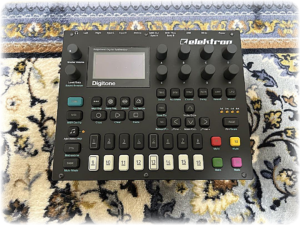 Indeed a really good choice for those looking for a familiar synthesis signal flow. Among its best advantages is based on its several FM techniques, featuring extensive curated parameters that encourage you to sculpt a diverse variety of noises. No matter if you seek retro leads, warm padding, or even gritty basslines, the Digitone produces with finesse. Featuring a vibrant 128 x 64 pixel OLED screen, navigating the Digitone’s extensive features and menus truly becomes a breeze after learning, keeping your creative juices flowing uninterrupted.
Indeed a really good choice for those looking for a familiar synthesis signal flow. Among its best advantages is based on its several FM techniques, featuring extensive curated parameters that encourage you to sculpt a diverse variety of noises. No matter if you seek retro leads, warm padding, or even gritty basslines, the Digitone produces with finesse. Featuring a vibrant 128 x 64 pixel OLED screen, navigating the Digitone’s extensive features and menus truly becomes a breeze after learning, keeping your creative juices flowing uninterrupted.
This analog synth features an over bridge that helps the users to implement your Digitone synth and sequencer directly into the DAW you prefer, assisting the audio to and from the component with the help of an individual USB cable. While using the Digitone users have an entire graphical interface to help control key features of this beautiful small synthesizer.
The Elektron Digitone is an analog FM synthesizer utilizing an integrated 8-voice sound engine, a live-performance-friendly sequencer, the means to control outboard MIDI equipment, and also full overbridge support, also including a dedicated VST/AU plug-in interface. Really what more can you ask for?
The device is made for heavy use and features high-resolution encoders, tough backlit buttons, along with a clean OLED screen allowing this particular machine to be in the category for best synthesizer under $1000
Moog Grandmother Dark Semi-Modular Analog Synthesizer
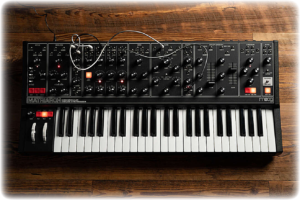 The Moog Grandmother semi-modular analog synthesizer is a true winner for the Moog brand altogether. The Grandmother seems to check all the important analog synth boxes plus it’s quickly turning into a modular fan favorite that usually draws a good amount of attention at any semi-modular analog synthesizer get-together.
The Moog Grandmother semi-modular analog synthesizer is a true winner for the Moog brand altogether. The Grandmother seems to check all the important analog synth boxes plus it’s quickly turning into a modular fan favorite that usually draws a good amount of attention at any semi-modular analog synthesizer get-together.
The Grandmother is an absolute must-have for almost any kind of music creative whether one experiencing as a hobbyist or even someone that is composing a film. It’s almost transforming into a studio need!
it’s a sonic playground that harkens directly back to Moog’s modular origins, in which synthesis is not merely about the outcome, but the path of discovery and experimentation. While competent at highly intricate noises and modulation, Grandmother’s semi-modular style and design need simply no patching, making sure that people of any skill level can readily explore and go through the miracles of analog synthesis.
Influenced by the timeless Moog modular synthesizers that came before it, Grandmother’s sound engine, modulation engine, and onboard spring reverb tank are solely analog, contributing to an unhindered sonic vocabulary of immeasurable power. In addition, Grandmother also features a user-friendly arpeggiator and sequencer for added excitement and automated syncopation.
Though not necessary, creative patching and exploration are the keys to discovering exciting new interactions between modules and to truly unleashing Grandmother’s limitless expanse of auditory inspiration. Patching can also be used to override internal connections, permitting each section to function in the same way an independent module would. To conclude, no matter how you decide to utilize it, the Moog Grandmother Dark will give you lifelong sound exploration.
Check out the best small synthesizers here
Moog Subharmonicon
![]() Granted how tricky the front panel appears, plus the seemingly endless musical possibilities it includes when you spend some time with it, the actual setup is user-friendly. The Subharmonicon carries a quarter-inch instrument output, as well as 12-volt power supply plugs that are located within the backside, the Subharmonicon doesn’t even possess a power switch. The front-facing patch bay includes many inputs.
Granted how tricky the front panel appears, plus the seemingly endless musical possibilities it includes when you spend some time with it, the actual setup is user-friendly. The Subharmonicon carries a quarter-inch instrument output, as well as 12-volt power supply plugs that are located within the backside, the Subharmonicon doesn’t even possess a power switch. The front-facing patch bay includes many inputs.
It’s even got a Midi input, amongst 31 other available choices for routing a variety of filters as well as oscillators.
The Subharmonicon is part of Moog Music’s Mother line of semi-modular synths. This elegant family includes the Drummer From Another Mother, the Mother 32, the Matriarch, & the Grandmother which is featured in this article. Even though this semi-modular synth didn’t get a Mom-themed identity due to it being a mashup of two other popular synthesizers.
Many musicians also love the pairing aspect of this particular device, creating a Moog stack where the Subharmonicon, DFAM, & Mother 32 are all patched through each other.
Although it’s not a standard analog synth, it’s truly an all-around musical instrument designed for people who would like to experiment with brief but developing sequences, and you’ll either enjoy it or question why Moog manufactured something that can initially seem limited but as you dive in deeper you’ll notice the endless possibilities.
Let’s be honest! It won’t appeal to everyone, I’m thrilled that Moog is willing and able to push the limits to create something that reaches beyond the sounds plus sequences that have popularized music for some time now. So, if you desire a wonderful-sounding synth, with all the traditional Moog trimmings, put the Subharmonicon on your buy list. It’s more than worth it.

